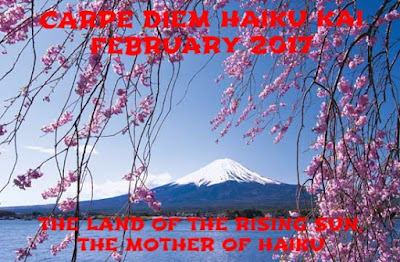Dear Haijin, visitors and travelers,
Several episodes ago I told you a little bit more about the tea ceremony and I treated you on a haibun about the tea ceremony. I love to go back to that haibun for a while with this quote:
[...] "The tea ceremony is coming to an end. I admire the earthenware tea bowls." [...]
The tea bowls are wonderful pieces of art work and they are created with a beautiful and aesthetic manner of pottery. This pottery is called Raku. And I love to tell you a little bit more about this other wonderful Japanese art form, Japan is really a country in which art is very important and we will see several kinds of Japanese art work this week. Yesterday I started with Ikebana and today that will be Raku, the Japanese way of pottery.
 |
| Black Raku Tea Bowl, with Crane |
Raku ware (raku-yaki) is a type of Japanese pottery traditionally used in Japanese tea ceremonies, most often in the form of chawan tea bowls. It is traditionally characterized by being hand-shaped rather than thrown; fairly porous vessels, which result from low firing temperatures; lead glazes; and the removal of pieces from the kiln while still glowing hot. In the traditional Japanese process, the fired raku piece is removed from the hot kiln and is allowed to cool in the open air.
Raku means "enjoyment", "comfort" or "ease" and is derived from Jurakudai, the name of a palace, in Kyoto, that was built by Toyotomi Hideyoshi (1537–1598), who was the leading warrior statesman of the time.
In the 16th century, Sen Rikyū, the Japanese tea master, was involved with the construction of the Jurakudai and had a tile-maker, named Chōjirō, produce hand-moulded tea bowls for use in the wabi-styled tea ceremony that was Rikyū's ideal. The resulting tea bowls made by Chōjirō were initially referred to as "ima-yaki" ("contemporary ware") and were also distinguished as Juraku-yaki, from the red clay (Juraku) that they employed. Hideyoshi presented Jokei, Chōjirō's son, with a seal that bore the Chinese character for raku. Raku then became the name of the family that produced the wares. Both the name and the ceramic style have been passed down through the family (sometimes by adoption) to the present 15th generation (Kichizaemon). The name and the style of ware has become influential in both Japanese culture and literature.
Raku ware marked an important point in the historical development of Japanese ceramics, as it was the first ware to use a seal mark and the first to focus on close collaboration between potter and patron. Other famous Japanese clay artists of this period include Dōnyū (grandson of Chōjirō, also known as Nonkō; 1574–1656), Hon'ami Kōetsu (1556–1637) and Ogata Kenzan (1663–1743).
 |
| White Raku teabowl Fuji-san (Mount Fuji) by Honami Kōetsu |
The above white tea bowl named Fuji-San is in my opinion the top perfection. I love these rough style non-glazed tea bowls to me this is the beauty and the aesthetic of Raku, but that's just my humble opinion.
I found a nice haiku by Basho which in a way directs to the tea ceremony:
A monk sips morning tea,
it's quiet,
the chrysanthemum's flowering.
© Matsuo Basho (Tr. Robert Hass)
Is he referring to the tea ceremony created by Rykyu? I don't know, but it creates that scene in a very nice way.
Or this beauty inspired on a tea bowl written by Kikusha-Ni
in the tea bowl
this motion of the clouds
of 'little spring'
© Kikusha-Ni (Tagama Kikusha Zennshu (1753-1826)
Kikusha-Ni describes a tea bowl in this one and it looks fabulous.
A last one written by Yozakura, the Unknown haiku poet:
in this tea house
the smell of cherry blossoms
scooping hot water
© Yozakura
Awesome!
 |
| Tea Bowl (Raku art) image found on Pinterest |
To close this episode about Raku I love to share a haiku from my archives. I wrote this back in 2014:
crystal clear water
ghostly curls of steam -
the perfume of tea
© Chèvrefeuille
And ... of course ... I have tried to create a new haiku also, more related to Raku:
perfection
this tea bowl
and cherry blossoms
this tea bowl
and cherry blossoms
© Chèvrefeuille
translucent tea cup
hides a deep secret
ghost of tea
geisha gathering tea leaves
for her lover’s ceremony
© Chèvrefeuille
Well .... I hope I have inspired you today. This episode is NOW OPEN for your submissions and will remain open until February 18th at noon (CET). Have fun!

No comments:
Post a Comment